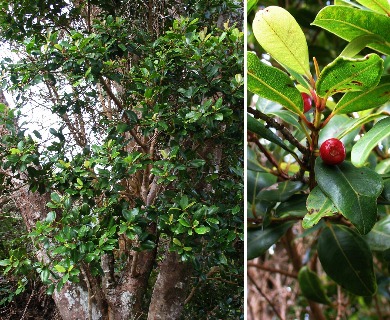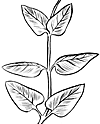'Ohi'a Ha
Syzygium sandwicense
Eucalyptus-Like family (Myrtaceae)
Native species ()
native tree of wet forests (except on the island of Hawaii), characterized by four-angled twigs, paired elliptical to oblong leaves, small white or pinkish flowers with many tiny and small rounded shiny red edible A large forest tree to 60 ft (18 ) high and 3 ft (0.9 ) in trunk diameter or shrubby on exposed ridges. Bark gray to reddish brown, smoothish to slightly fissured; Inner bark is light brown, slightly astringent. Twigs four-angled and slightly winged, slightly enlarged at ringed hairless, greenish when young, turning brown.

©2010 David Eickhoff
Flower clusters () 1 1⁄2–3 inches (4–7.5 ) long at bases of upper leaves, with four-angled branches. Flowers several to many on stalks of 1⁄8 inch (3 ), about 5⁄16 inch (8 ) long and wide, composed of funnel shaped greenish base (), four pinkish rounded on rim, four rounded fringed white or pinkish petals less than 1⁄8 inch (3 ) long, many tiny white and with inferior two-celled and short
(berries) are rounded and slightly flattened, 5⁄16– 3⁄8 inch (8–10 ) in diameter, with at top, shiny red, with slightly sour edible white pulp. Seeds 1–2, 1⁄8 inch (3 ) long. are often abundant in late summer. The wood is described as reddish brown, hard, and durable; it was used as fuel and for house construction by the Hawaiians. The bark furnished a black dye for tapa or bark cloth.
Common and widespread in lower and middle wet forests to 4000 ft (1,219 ) altitude.
Special area
Kokee
Range
Kauai, Oahu, Molokai, Lanai, and Maui
Other common names
hā, pā‘ihi (Maui), Hawaiian syzygium
Botanical
Eugenia sandwicensis A. Gray






